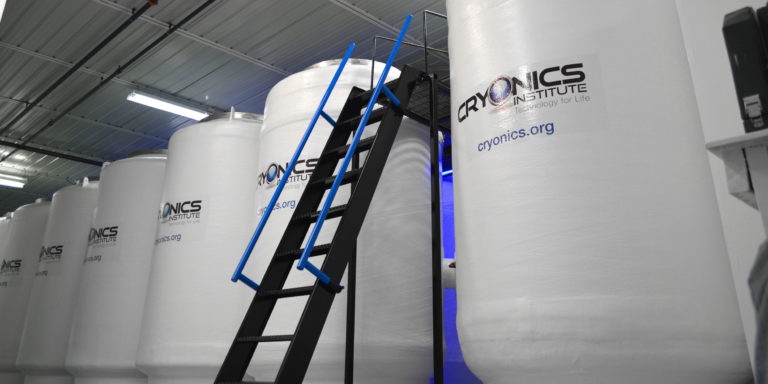



Perhaps those who die today will be able to come back to life in the future. But this is not certain.
What is cryonics
Cryonics is technology used to freeze the body, head, or just the brain of a deceased person or animal. The process is called cryopreservation.
In the telegram channel ” Iodine ” we tell you how to take care of your health, relying on evidence-based medicine.
This is a kind of experiment. The idea is to slow down or stop the destruction of a body or organ immediately after death and preserve them in the most intact state possible. Freezing is done with the hope of reviving a person in the future. Cryonicists should be able to achieve this with technologies that do not yet exist.
So far, the scenario of people being revived after being frozen has only been found in fiction. For example, in the animated series Futurama, the books The Three-Body Problem by Liu Cixin and The Aviator by Evgeny Vodolazkin.
How to freeze a human body
A person can only be frozen after he or she has died and doctors have confirmed brain death. Otherwise, cryopreservation would be murder.
As soon as the heartbeat stops, irreversible changes begin in the body’s tissues, so cryonics specialists strive to carry out cryopreservation as quickly as possible.
The ideal sequence of actions looks like like this:
- Circulation support and ventilation. If a person is dying, a team from a cryonics company is on duty with them, ready to begin cardiopulmonary support after death is confirmed. That is, using special equipment to maintain circulation and ventilation of the lungs so that organs and tissues do not begin to deteriorate. Ideally, the procedure should begin within 15 minutes after death. If a person dies suddenly, then their relatives contact the company, and a team goes to the hospital or home.
- Cooling the body. Using a special device with ice water, cryocompany workers cool the body to 0-10 °C to slow down the metabolism.
- Perfusion. Blood is removed from the body and replaced with a special non-freezing solution – a cryoprotector. It preserves organs and, when frozen, reduces the formation of ice crystals that damage tissue cells.
- Freezing. The body or brain is lowered into liquid nitrogen and frozen to a temperature of -196 °C. Then it is placed in a special vacuum chamber – a Dewar vessel. The body can be stored in such a chamber indefinitely, so it is there that the deceased or his brain will await the technologies of the future.

What Cryonics Offers to the Deceased and Their Relatives
Cryonics companies offer a futuristic scenario: If the entire body is frozen , then in the future, it may be possible to restore both the physical and cognitive state of a person or animal.
Brain freezing is based on the hypothesis that a person’s personality, memory, and consciousness are stored in the structures of the organ. If the brain is preserved , it will supposedly be possible to transplant it into a new body, which will be restored using human DNA. Another option is to attach the brain to a donor body.
How cryonics companies promise to revive people and animals
How to revive people, no one knows now. Cryocompanies are counting on the fact that in some tens, hundreds or thousands of years scientists will find the necessary method. In the meantime, hope for future resurrection rests on two pillars.
Use technologies that are developing now
Cryocompanies expect that some of the already known technologies will help to revive frozen people in the future . Here is what they include:
- organ cultivation,
- artificial organs,
- computer modeling of brain function,
- 3D printing of organs,
- transplantation of donor organs.

Alexander Panchin
Candidate of biological sciences, member of the Russian Academy of Sciences commission to combat pseudoscience.
I think that we will be able to grow almost any organs soon enough. But I would place my bets primarily on genetically modified animals, primarily pigs. There are already cases of successful heart and kidney transplants to humans.
Only if a person can be cured by transplanting an organ, then the disease is unlikely to cause death. Therefore, it cannot be said that this is the technology that will help revive people.
Wait for new technologies
Here’s what scientists need to do to make cryonics’ promises come true:
- Find a way to restore cells damaged by cryopreservation. Despite the use of cryoprotectors, it is still impossible to completely avoid the formation of crystals.
- Learn how to safely defrost your body or brain to avoid damage.
- Understand how to “connect” the brain to a new body or computer to restore the personality of the brain’s owner.
- Learn to treat diseases from which cryonics patients died, as well as rejuvenate the bodies of elderly people.
Cryonics companies hope that all this could appear in the next 50-100 years, although they admit that this is just guesswork.

Alexander Panchin
The primary problem today is that we don’t know how to freeze large tissues and organs without damaging them. And the technologies that would help repair this damage aren’t even on the horizon.
The record in this matter is a rabbit kidney, which was frozen, then defrosted and transplanted into another rabbit. But this animal’s kidney is very small. Another example is a frozen piece of brain, but again, its size was four millimeters.
The difficulty is that cryoprotectants used during freezing must get absolutely everywhere. And the larger the size of the frozen object, the harder it is to ensure this. In addition, it is difficult to make a uniform freezing of a large object. Something small freezes quickly and uniformly, but a large object has a difference between the external and internal temperatures.
It turns out that as soon as a body or organ is frozen, it is already damaged.
So now we should worry not about what technologies will appear in the future, but about how to learn to make freezing more effective today. Scientists study different animals that can survive low temperatures: there are fish, insects, frogs. This is comforting, and perhaps we will be able to study how they do it.
Does it make sense to freeze the body after death?
Technically, only severe damage could be an obstacle to a possible future revival. But in terms of future technologies, no one knows where to draw the line between “possible” and “impossible to restore.”
Cryonics companies agree that the less damage a person sustained at death, the higher the chances of restoring and reviving him in the future. An exception may be a situation where only ashes remain from the deceased.
Who does cryonics and how much does it cost?
If you want to invest in an experiment, there are several options.
| Company | Country | Freeze the whole body | Freeze the brain |
| Alcor | USA | $220,000 | $80,000 |
| Cryonics Institute | USA | from $28,000 + annual membership fees from $120 | no separate service |
| KrioRus | Russia | from 3 800 000 ₽ | from 1,800,000 ₽ |
| Yinfeng Life Science | China | $275,000 | no separate service |
| Tomorrow Bio | Germany | $200,000 | $80,000 |
During life, you can write a will and indicate your wish to be frozen after death. It is also advisable, while still alive, to sign a contract with a company that will perform cryonics and store the body after death. Then, after actual death, the body will be transferred to a cryonics company, where it will be preserved. But it seems that there is no point in this for now.

Alexander Panchin
At the current stage of technological development, I don’t see any practical sense in freezing myself. But there is sense in developing this science and supporting scientists who are engaged in cryonics and research in this area.
What are the ethical, medical and legal issues with cryonics?
Cryonicists have no answers to important questions about reviving people in the future. For example:
- What to do if a person who comes back to life after half a century turns out to be a carrier of an infection that was defeated during this time?
- What legal status will a person have who comes back to life in 50-100 years if the only document he has is a death certificate?
- Will a person from the 21st century be able to feel comfortable in the society of the new era?
Probably, modern cryonics companies leave the solution of these issues to the people of the future.

Alexander Panchin
Improvements in freezing technologies will help solve current problems. For example, transporting donor organs. Now one of the difficulties is that even if there is a donor organ, it is difficult to quickly deliver it to the patient so that the kidney or liver does not have time to deteriorate.
In this sense, the interest in cryonics that cryonics companies generate is of unobvious benefit to science. Although I have a very controversial attitude towards the companies themselves. They promise dying people something that doesn’t really work. I would perceive them more as funeral services.
